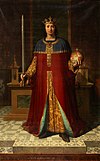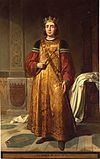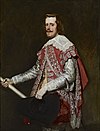List of Castilian monarchs

| Monarchs of the Iberian Peninsula |
|---|
This is a list of kings regnant and queens regnant of the Kingdom and Crown of Castile. For their predecessors, see List of Castilian counts.
Kings and Queens of Castile
[edit]Jiménez dynasty
[edit]| Monarch | Image | Epithet | Reign began | Reign ended | Notes |
|---|---|---|---|---|---|
| Sancho II | 
|
the Strong | 27 December 1065 | 6 October 1072 | also King of Leon (January- October 1072) |
| Alfonso VI | 
|
the Brave
the Valiant |
6 October 1072 | 30 June 1109 | also King of León |
| Urraca | 
|
the Reckless | 30 June 1109 | 8 March 1126 | also Queen of León |
House of Ivrea
[edit]
The following dynasts are descendants, in the male line, of Urraca's first husband, Raymond of Burgundy.
| Monarch | Image | Epithet | Began | Ended | Notes |
|---|---|---|---|---|---|
| Alfonso VII | 
|
The Emperor | 10 March 1126 | 21 August 1157 | also King of León |
| Sancho III | 
|
The Desired | 21 August 1157 | 31 August 1158 | |
| Alfonso VIII | 
|
The Noble | 31 August 1158 | 6 October 1214 |
16 July 1212 won a decisive victory for the Reconquista at the Battle of Las Navas de Tolosa |
| Henry I | 
|
6 October 1214 | 6 June 1217 | ||
| Berengaria | 
|
The Great | 6 June 1217 | 30 August 1217 | abdicated in favor of her son, Ferdinand III; died 1246 |
| Ferdinand III | 
|
The Saint | 30 August 1217 | 30 May 1252 | also King of León from 1230; all later kings were King of León as well |
| Alfonso X | 
|
The Wise | 30 May 1252 | 4 April 1284 | elected King of the Romans in 1257, a title which he claimed until he renounced it in 1275 |
| Sancho IV | 
|
The Brave | 4 April 1284 | 25 April 1295 | |
| Ferdinand IV | 
|
The Summoned | 25 April 1295 | 7 September 1312 | |
| Alfonso XI | 
|
The Just | 7 September 1312 | 26 March 1350 | Infected and killed by the Black Death during the Fifth Siege of Gibraltar (1349–1350) |
| Peter | 
|
The Cruel | 26 March 1350 | 23 March 1369 | Killed by Henry II of Castile |
Civil War
[edit]In 1366, Peter's conduct led to an uprising by his illegitimate half-brother Henry with support from France and Aragon. After three years, Henry triumphed in 1369, and personally executed Peter.
House of Trastámara
[edit]
Henry II, the founder of the Trastámara dynasty was installed after victory in the Castilian Civil War.
| Monarch | Image | Epithet | Began | Ended | Notes |
|---|---|---|---|---|---|
| Henry II | 
|
The Bastard | 23 March 1369 | 29 May 1379 | Illegitimate son of Alfonso XI and his mistress Eleanor de Guzmán. Also half-brother to Peter. Peter's unpopularity led to Henry's successful rebellion against him in the Castilian Civil War, beginning in 1366 and ending in 1369 with Henry on the throne. |
| John I | 
|
29 May 1379 | 9 October 1390 | Eldest son of Henry II. A dynastic challenge by John of Gaunt, son-in-law of Peter I, was resolved by marriage, with John I taking John of Gaunt's daughter [[Catherine of Lancaster|Catherine] as his wife and queen. | |
| Henry III | 
|
The Infirm | 9 October 1390 | 25 December 1406 | Eldest son of John I. He was age 11 on ascension, but after an unstable regency, took power while still only 13. |
| John II | 
|
25 December 1406 | 21 July 1454 | Eldest son of Henry III. He was a minor on ascension, and so placed under a regency. From 1406, his mother Catherine and uncle Ferdinand I of Aragon were co-regents until his death in 1416. From then his mother alone until her death in 1418. | |
| Henry IV | 
|
The Impotent | 21 July 1454 | 11 December 1474 | Eldest son of John II. |
| Isabella I | 
|
The Catholic | 11 December 1474 | 26 November 1504 | Half-sister of Henry IV. Her succession was disputed by partisans of Henry's (allegedly illegitimate) daughter Joanna, resulting in the War of the Castilian Succession, which lasted until 1479, with the resolution in Isabella's favor.
Isabella's husband Ferdinand, ruled with her as co-monarch of Castile, while on his ascension to the Crown of Aragon, she ruled as co-monarch of Aragon. |
| Ferdinand V | 
|
The Catholic | 15 January 1475 | 26 November 1504 | Co-monarch through his wife Isabella. In 1479, Ferdinand succeeded his father to the Crown of Aragon, uniting the realms by marriage, laying the foundation for the modern nation of Spain.
On Isabella's death, as she was succeeded by their daughter Joanna I and her husband Philip I. Ferdinand, no longer king, then left the Castile and returned to Aragon. But after her husband Philip's death in 1506, Joanna proved unable to rule, and Ferdinand was recalled, after which he governed Castile as her regent until his death in 1416. |
| Joanna I | 
|
The mad | 26 November 1504 | 12 April 1555 | In name, with her husband Philip I (1504–1506). with regent Archbishop Cisneros (1506-1508). in confinement from 1509, with her father Ferdinand V as regent (1508–1516). in confinement, with her son Charles I as co-monarch (1516–1555) |
House of Habsburg
[edit]
| Monarch | Image | Epithet | Began | Ended | Notes |
|---|---|---|---|---|---|
| Philip I | 
|
The Handsome | 26 November 1504 | 25 September 1506 | jure uxoris king ruling on behalf of his wife, Joanna I |
| Charles I | 
|
The Emperor | 13 March 1516 | 16 January 1556 | jointly with his mother Joanna I in confinement to 1555, abdicated in favor of his son 1556, died 21 September 1558. |
| Philip II | 
|
The Prudent | 16 January 1556 | 13 September 1598 | son of Charles I and Isabella of Portugal |
| Philip III | 
|
The Pious | 13 September 1598 | 31 March 1621 | son of Philip II and Anna of Austria |
| Philip IV | 
|
The Great | 31 March 1621 | 17 September 1665 | son of Philip III and Margaret of Austria |
| Charles II | 
|
The Bewitched | 17 September 1665 | 1 November 1700 | son of Philip IV and Mariana of Austria |
House of Bourbon
[edit]
| Monarch | Image | Epithet | Began | Ended | Notes |
|---|---|---|---|---|---|
| Philip V | 
|
1 November 1700 | 1715 (Nueva Planta decrees dissolve the Crown of Castile) | Duke of Anjou, half-grandnephew of Charles II (via Maria Theresa of Castile) |
The Crown of Castile existed in its own right within the Spanish crown and with its own law until the arrival of the Bourbon dynasty after the War of Spanish Succession.
See also
[edit]- List of Castilian consorts
- Kingdom of Castile
- List of Aragonese monarchs
- List of Leonese monarchs
- List of Navarrese monarchs
- List of Spanish monarchs
Further reading
[edit]- Barton, Simon. The Aristocracy in Twelfth-Century León and Castile. Cambridge University Press, 1997. Appendix I: "The Counts of Twelfth Century León and Castile and Aragon, pp. 235–302.

